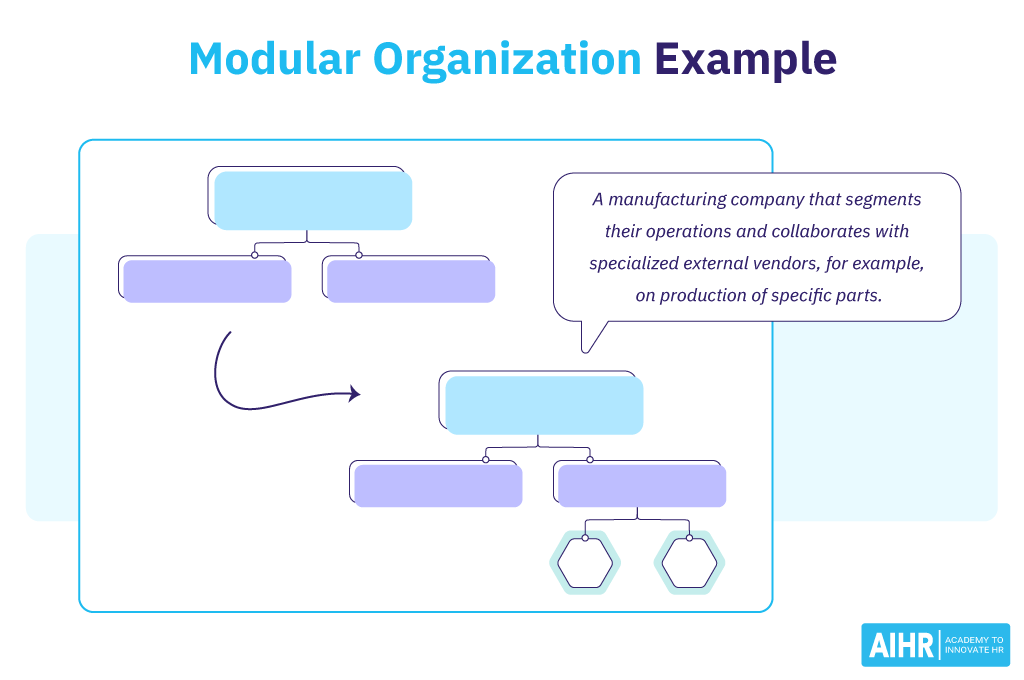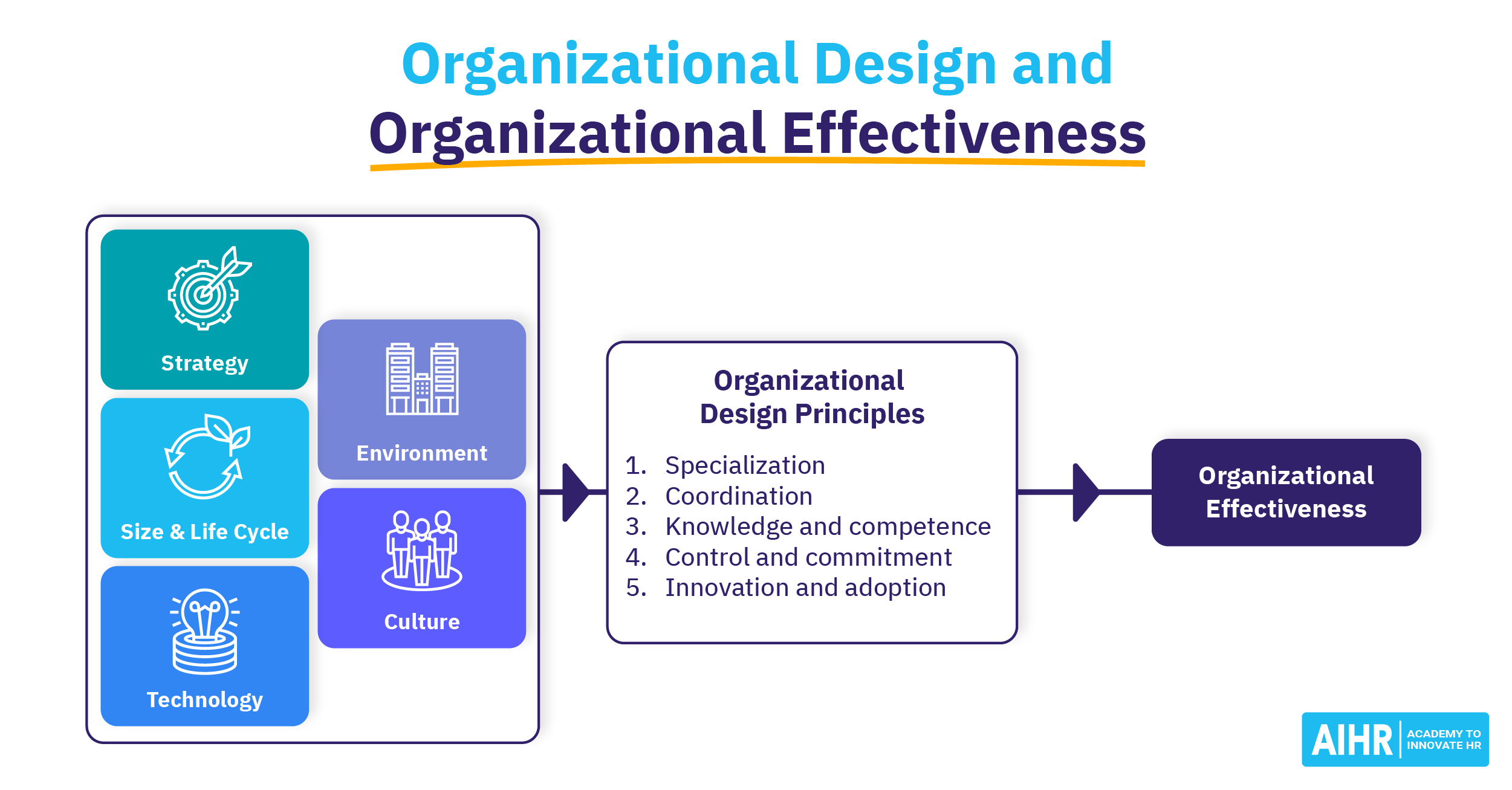Modular Organization
What is a modular organization?
A modular organization is a structure where business operations are divided into separate, semi-autonomous units or modules. These modules can operate independently but are coordinated and integrated to achieve the organization’s overarching goals. This structure allows the organization to outsource specific functions or processes to external providers, focusing on core competencies while maintaining flexibility and efficiency.
A software company may adopt a modular organization by outsourcing customer support, payroll, or marketing to specialized firms while concentrating on product development and innovation. The outsourced activities are considered modules of the organization’s structure, with well-defined roles and standardized processes.
This type of organizational structure is becoming increasingly popular as businesses strive to remain adaptable and agile. Breaking down the company into smaller, easily manageable modules makes it easier to adapt to external changes and market needs and move and allocate resources across organizational priorities.

Characteristics of a modular organization
Some of the most significant characteristics of a modular organization structure include:
- Independent units: The organization is divided into self-contained modules, each handling a specific function while operating semi-autonomously.
- Outsourcing of non-core activities: Specialized tasks are outsourced to external providers, allowing the organization to focus on its core strengths.
- Standardization and integration: Modules follow standardized processes to ensure seamless integration with the overall organization.
- Flexibility and scalability: The structure allows easy scaling and adaptation by adding or modifying modules based on business needs.
- Central coordination: A central hub oversees and aligns the modules to maintain consistency and strategic direction.
Modular organization examples
When organizations change, a modular type of organizational design is easier to scale or wind down. It also allows more flexibility than a traditional functional hierarchical organization. This helps contain costs and enables the organization to move resources quickly between projects.
Here are some examples of modular organizational design.
Software companies
The structure of many software companies is a well-known example of a modular organization. In these companies, distinct units focus on specific responsibilities—such as software development, customer support, or IT infrastructure—and many of these functions are outsourced to external vendors.
For instance, customer support might be managed by a specialized service provider, while development teams handle core product innovation. This approach allows the organization to concentrate on its core competencies while leveraging the expertise of external partners for non-core activities.
Manufacturing companies
Manufacturing companies also often operate as modular organizations by segmenting their operations and collaborating with specialized external vendors. For example, an automotive company may design and assemble vehicles in-house while outsourcing the production of specific parts—such as engines, electronics, or interior components—to trusted suppliers.
Flexible resource pools
Another example is organizations with a flexible resource pool, often managed by a Project Management Office (PMO) or Resource Management Office (RMO). These offices coordinate both in-house talent and outsourced resources to strategically deploy them to high-priority initiatives.
Additionally, some companies maintain small modular teams within the Office of the CEO/COO, focusing on strategic projects and often relying on external consultants or contractors to provide specialized knowledge.
Real-world examples
Here are some examples of companies that use a modular organizational structure:
- Toyota: Toyota employs a modular approach by working with various suppliers that produce specific vehicle parts. The company then assembles these components in its production facilities to create a final, cohesive product.
- IKEA: IKEA designs its furniture and sells it under its brand, but manufacturing is outsourced to various suppliers worldwide. Each component is produced separately and then assembled by customers, making it a great example of a modular system.

Advantages of a modular structure/organization
There are several advantages to a modular organization structure:
- It allows for more flexibility and adaptability. With a modular organization, you can easily change the way different parts of the company work without having to make major changes to the entire company.
- Makes it simpler to scale up or down depending on what is required. If your company is expanding at a quick rate, you have the ability to add additional modules as required. In the event that business is sluggish, you have the option of reducing the number of modules without having to dismiss staff or shut down areas of the organization.
- The flexibility afforded by a modular design fosters inventiveness and creativity. You can encourage greater creativity and innovation in the workplace by empowering the various divisions of the firm to do their own research and come up with fresh concepts on their own. This has the potential to contribute to increasing levels of production and earnings.
- Build institutional knowledge. A modular design lends itself toward building institutional knowledge as employees move across various areas of the business and get to know and understand how the interrelated parts function. Often this allows for new ideas or greater alignment to emerge, which leads to better performance.
Disadvantages of a modular structure/organization
The use of a modular organizational system comes with a few significant drawbacks to consider.
- Dependency on external vendors: Relying on third-party providers for critical functions can create vulnerabilities, especially if the vendor fails to meet deadlines, quality standards, or operational commitments.
- It may become challenging to manage a modular system as it expands and changes over time: In case the modules are not well maintained, they have the potential to become disorganized and difficult to control. The need to integrate multiple autonomous units, both internal and external, can lead to misaligned objectives, delays, or miscommunication, reducing overall efficiency.
- Developing and preserving standard operating procedures across a variety of modules may be complex: This might result in inconsistencies in the way work is completed, which in turn reduces the overall efficiency of the business.
- Risk of reduced control over outsourced functions: Outsourcing non-core activities may limit the organization’s ability to oversee processes directly, potentially leading to quality concerns or conflicts with organizational standards.
- The use of a modular structure might be quite intimidating for individuals who are just starting out with the company: They could have a hard time comprehending how the system operates and figuring out where they are in relation to the bigger picture.
- Modular systems require robust governance and management to be effective: If not managed well, modular systems can become slow, costly, and ineffective.
FAQ
A modular organization is a structure where a company or entity is divided into self-contained, independent units or modules that can function separately but work together to achieve overall goals. These modules, often outsourced to specialized providers, focus on specific tasks or processes while the core organization oversees integration and strategic direction. This structure enhances flexibility, scalability, and efficiency.
A hollow organization outsources entire functions such as HR or manufacturing, keeping only core strategic activities in-house. In contrast, a modular organization outsources specific components or parts of a product while retaining integration and quality control. Hollow structures focus on reducing operational scope, whereas modular structures emphasize assembling outsourced parts into a final offering.









